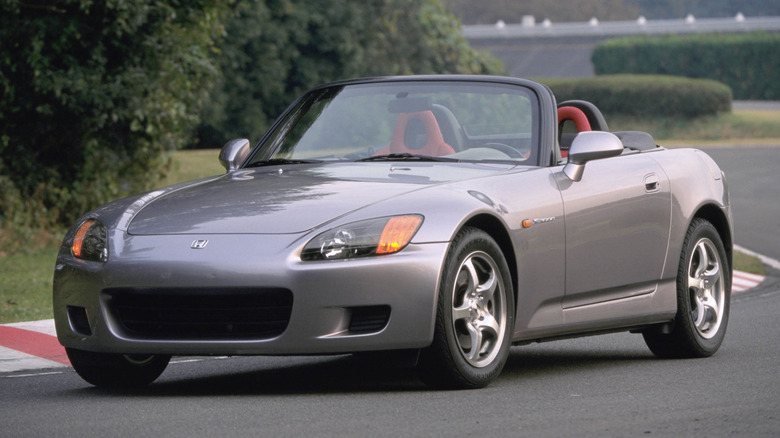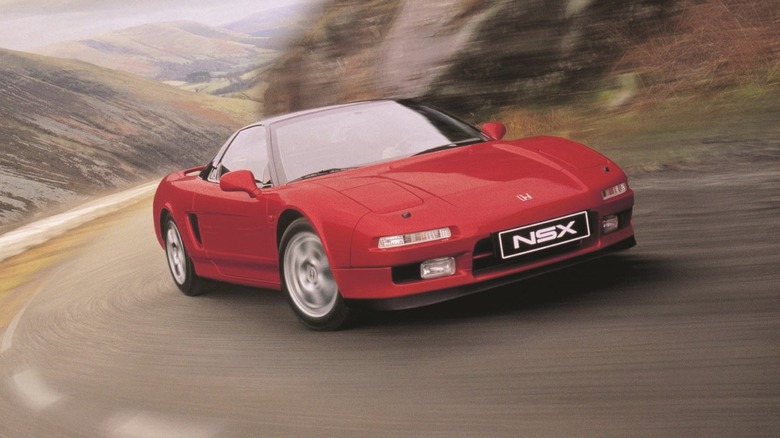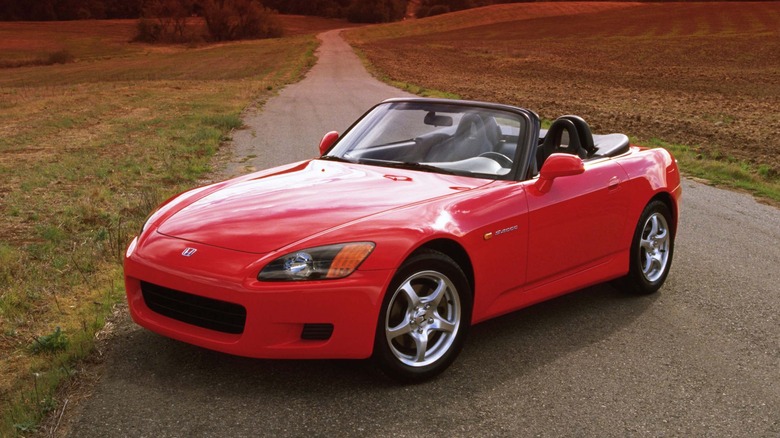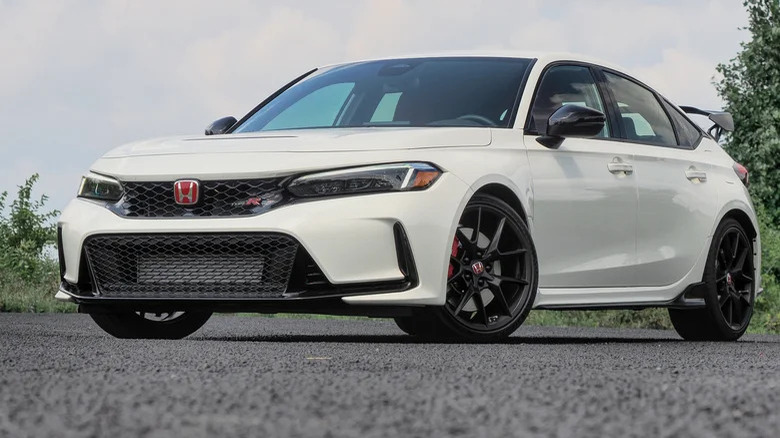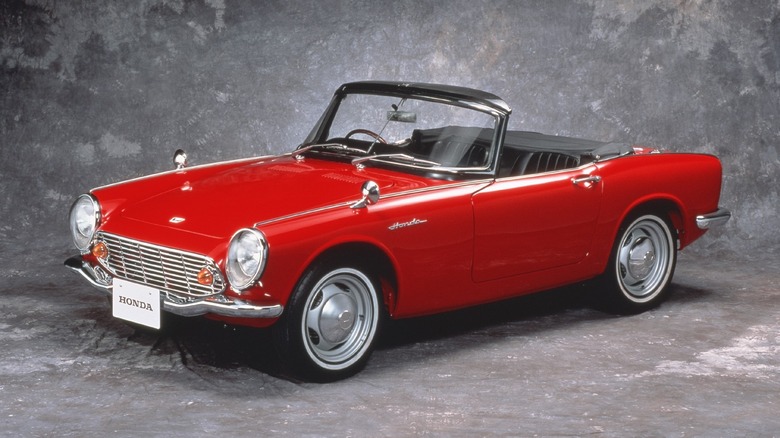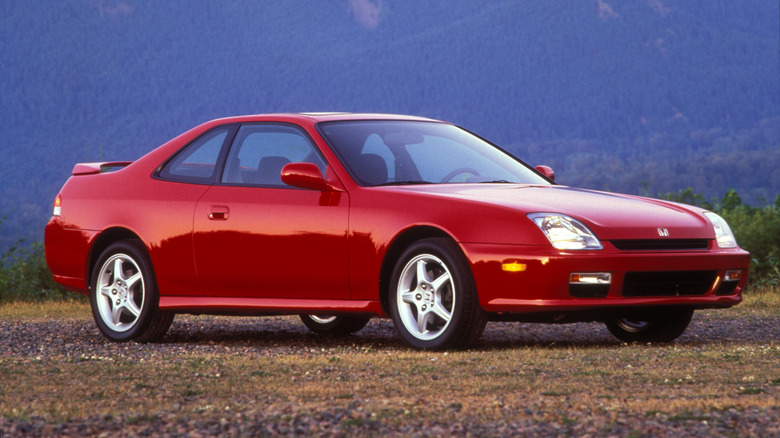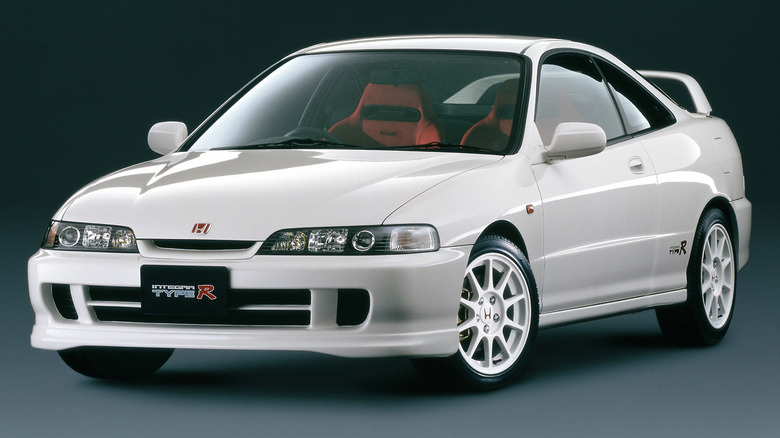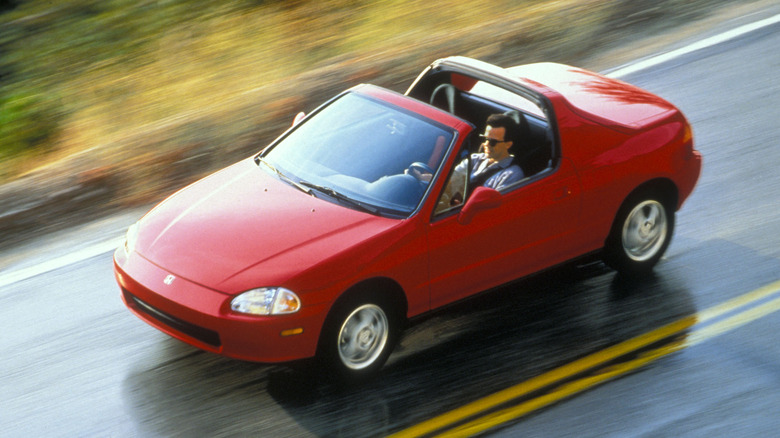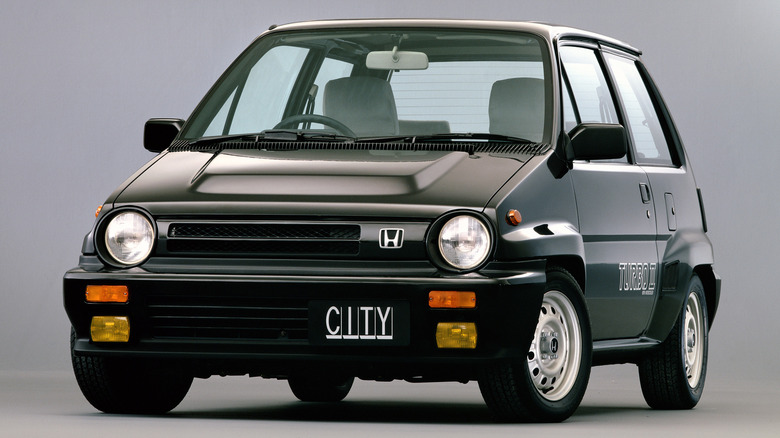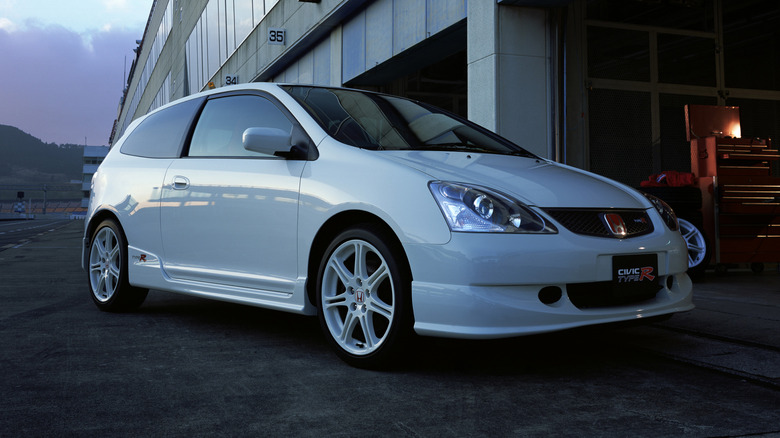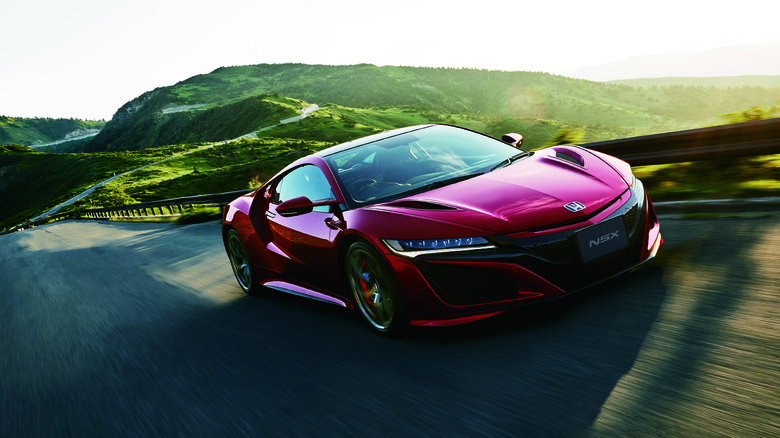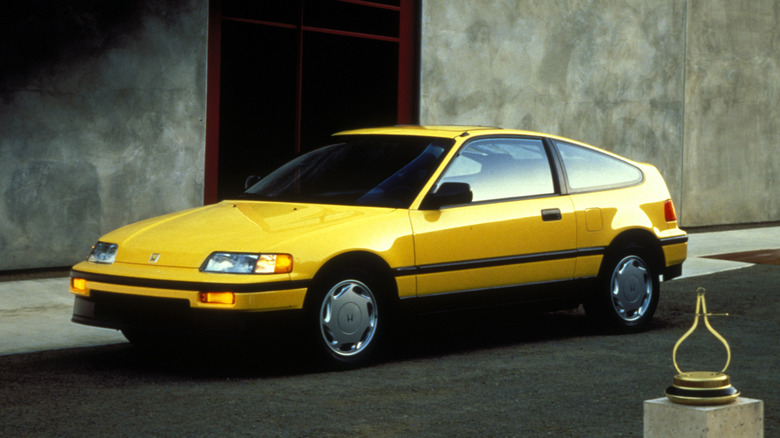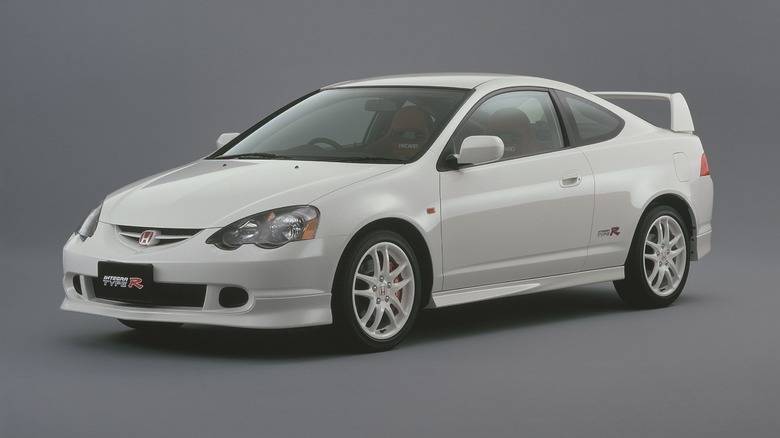12 Of The Best Looking Honda Models Ever Designed
Honda might not be the first manufacturer that most enthusiasts think of when it comes to creating good looking cars, but the Japanese auto giant has had its fair share of aesthetically pleasing models over the decades. In most cases, Honda's car designs are intended to appeal to as wide an audience as possible, and as a result, they can be on the conservative side. While rivals Nissan and Toyota have also produced some thoroughly weird cars alongside their mass-market models, Honda has been largely content to stick to its tried and tested styling.
There are, of course, a few notable exceptions to this general attitude of conservatism. Many of the brand's bolder designs have become enthusiasts' favorites, and in some cases, even influenced the design choices of rival manufacturers. In addition, plenty of the brand's safer designs have aged well over the years and are considered among the best looking cars of their kind today. To showcase both sides of Honda's styling history, SlashGear rounded up a selection of both pioneering and classically attractive designs which particularly stand out above the rest.
Honda/Acura NSX (first generation)
Much has already been written about the impact that the first generation Honda/Acura NSX had on the market. Most enthusiasts will already be aware of its impact on not just Honda but on the supercar segment as a whole — but its styling is a key and sometimes overlooked element of its impact. The NSX still looked contemporary when Honda discontinued it in 2005, having first unveiled the car in 1989. In that time, its only styling change was a modest facelift. Given the drastic shift in styling trends over that time period, that's a remarkable achievement in itself.
When the NSX was first launched, many of its rivals still featured the boxy styling that had become popular throughout the '70s and '80s, but a new wave of performance cars would launch that made that older styling quickly obsolete. The NSX was one of the first to feature this new, sleek, and aerodynamically-led design, alongside other Japanese pioneers like the Z32 Nissan 300ZX and Mazda RX-7 FD. British classics like the TVR Griffith also deserve a mention as design pioneers of the era.
Arguably none of those other cars, however, had quite such an immediate design impact as the NSX. It looked like nothing else on the road, and it drove like nothing else on the road, too, boasting both world-class performance and an unprecedented level of everyday usability. That never translated into high sales figures, but remaining examples are sought after today.
Honda S2000
The Honda S2000 is already considered a modern classic, but that's not because of its styling. Instead, it's the car's high-revving engine that's the main draw for enthusiasts, boasting a character that's unlike any other production Honda built since. It's an engine that's designed to live in the upper half of its rev range, and as a result, it's easy to overlook the car's abilities when driving it at a more everyday pace. Indeed, some reviewers and buyers did exactly that at launch, criticizing its lack of low-end torque, but the ballooning value of pristine examples today proves that many have since come around to its charms.
It helps that the S2000 is one of Honda's best looking cars to date, with a simple, timeless design that's aging a lot more gracefully than many of its contemporaries. The long hood and compact proportions of the rest of the car are reminiscent of the earliest S-series Honda roadsters, but without dipping into the dated retro-modern bubble styling that many other late-'90s cars employed. Honda was well aware that it had nailed the styling of the S2000 on the first try, and over its decade or so in production, the car was subject to only minimal design changes.
Honda Civic Type R FL5
It might be a perennial bestseller, but that hasn't stopped Honda from subjecting the Civic to a series of significant design changes over the years. Some have worked out better than others. Few would argue that the helmet-like styling of the Euro-spec eighth generation Civic has aged well, but the overhaul given to the latest generation Civic is much more of a triumph. The car looks naturally more athletic than its predecessor even in standard spec, and although the latest Civic Type R is less eye-catching than the last generation, it's arguably the better looking car overall.
In fact, SlashGear gave the FL5 Civic Type R a 10/10 rating, arguing that its combination of everyday practicality, comfort, and track-ready performance made it one of the best attainable performance cars on sale today. It also wins extra enthusiast points for being available as standard with a six-speed manual transmission, an increasingly rare occurrence in today's market. Not only is the Type R a blast to drive, but the unique wheels, rear wing, and prominent red badging ensures it looks good too, without as much of the polarizing teen racer vibe that the previous generation offered.
Honda S600
The first car ever exported by Honda remains one of its biggest styling triumphs, with diminutive proportions and mechanical influence from Honda's line of motorcycles. The S600 is a far cry from the Hondas that have become bestsellers in recent decades, with a small, rev-happy engine and a design that takes inspiration from the British roadsters that Honda was looking to rival at the time. It was these unconventional roots that set it apart from other Japanese cars at its launch and continue to make it a desirable collectors' car six decades later.
It proved a bigger success than the brand's previous S500 roadster, which had only been sold in Japan. The S600 shifted around 11,000 units over the course of three model years, with a significant number of those units going to export markets like Europe and Canada. Its European looks and Japanese heritage make a uniquely attractive combination for collectors, even if the car's unconventional motorcycle-derived mechanicals mean that keeping one in good condition requires specialist expertise and a healthy wallet.
Honda Prelude (5th generation)
Honda recently announced the return of the Prelude for a 6th generation, with the car set to launch in select markets as soon as 2025. That makes it a great time to look back at the 5th generation car, which arguably doesn't get the recognition it deserves. The Prelude nameplate has a long history stretching back to the '70s, so by the time the 5th generation car was unveiled in 1997, Honda had significantly refined the formula. The first generation Prelude was considered too slow to be properly sporty, but the 5th generation offered considerably more grunt.
It wasn't a sports car in the truest sense, but was certainly sporty, with its handling being the main selling point rather than straight line performance. It was pitched as a grown-up coupe for buyers who wanted something more comfortable and refined than Honda's other sporty offerings, but didn't want to compromise on driving enjoyment. Its styling reflected that brief, being understated but handsome. For now, it remains a relatively overlooked part of Honda's history, but if the new Prelude is the hit that Honda is hoping for, it might not stay that way forever.
Honda/Acura Integra Type R DC2
It's safe to say that no-one is buying an Integra Type R for its looks alone. It's regarded as one of the best handling front-wheel-drive cars available and boasts an engine that runs best at the top end of its rev range, plus with less driving assists than most modern cars, it's a purists' favorite. All those factors already earn it a place as one of Honda's best cars, but it helps that it's also one of the brand's best looking cars to boot, particularly when it's wearing a JDM front end.
If it wasn't the Type R badges that gave away the fact that it's no ordinary Integra, the prominent rear wing and unique rims should have removed any doubts among onlookers. The regular Integra was already a good looking car, if a little conservative compared to some other sporty compacts of its era. The Type R flourishes added just the right level of visual distinction, turning the car into something that's instantly recognizable to enthusiasts in the know without veering too close to being obnoxious like some later Honda Type R models.
Honda CR-X Del Sol
As many carmakers have found out to their cost, creating a followup to a much-loved model is a tricky task. Change the formula too little and critics can accuse the car of being stale, but change it too much and there's a risk that the new car loses the unique appeal that made the old one a winner. The CR-X Del Sol, sometimes referred to as the Civic Del Sol or simply the Del Sol, certainly had its share of critics, with many of them arguing that this newer car was simply too different to the original CR-X. It weighed more, it wasn't as sharp to drive, and its removable roof became known for its unreliability — surely a cardinal sin for any Honda.
Still, there's a lot to like about the Del Sol in retrospect. Its Civic bones make it an affordable car to maintain, and it's still a small and nimble car by modern standards. It's also fairly practical given its size, with Honda equipping the car with plenty of storage space and cabin cubbies. It's also still a good looking car, with its rounded design clearly resembling the Civic upon which it was based but still managing to have a quirkier, sportier appearance than its hatchback sibling. Its mixed reputation has ensured that it has remained firmly in affordable territory even as other Japanese cars from its era have soared in value, although clean, cheap examples are no longer as easy to find.
Honda City Turbo II
The Honda City Turbo II is a controversial pick in that it isn't good looking in the traditional sense — there's no elegant, flowing bodywork or timeless appeal here. Yet, the car's upright, boxy stature and retro graphics give it a funky charm that's missing from a lot of modern cars, including most of Honda's current lineup. It's certainly dated, but the City Turbo II has a personality, and is a firm reminder that affordable, everyday cars don't have to look boring.
Most enthusiasts who are already aware of the car will know it by the vehicle designed to fit in its trunk. The Motocampo was a mini-motorcycle designed to zip around narrow Japanese city streets, and could fold up to fit neatly in the back of the City Turbo II. The pair together made a catch-all solution for urban transport, but thanks to its modest power output and tiny footprint, it never caught on outside of Japan. Its distinctly '80s style, alongside its unique complimentary minibike, have kept it a sought after cult classic.
Honda Civic Type R EP3
Not everyone liked the look of the Civic Type R EP3 at its launch, but it has arguably aged well and now stands as one of Honda's better-looking Type R cars. It follows the precedent set by the previous generation Civic Type R and adds a relatively modest set of visual upgrades to distinguish it from the regular Civic, with new rims, a body kit, and Type R badging. At least, it's certainly modest compared to newer generations, although at the time it wasn't looked at as such.
The EP3 was the first car to feature Honda's K20 engine, which would go on to become an enthusiast's favorite and develop a following in its own right. The EP3's biggest selling point was indeed that engine, but the fact that it was available under the hood of a practical, affordable compact car sealed the deal for many buyers. Many examples were used as intended, being driven hard for many years, and as a result it's not too common to see clean, low mileage examples in the markets where the EP3 was sold. America was not one of those markets, but the car is now only a few years off being old enough to be imported under the 25 year rule.
Honda/Acura NSX (second generation)
Virtually every Honda enthusiast has an opinion about the second generation NSX. Some are positive and some are negative, but SlashGear's takeaway after spending some time with the NSX Type S was that the naysayers were missing the point with the car. It was indeed a more easily accessible and practical supercar than most of its contemporaries, and it made going fast an almost unsettlingly easy task. Our reviewer was thoroughly convinced that was no bad thing.
The NSX also looks just as striking as any other supercar, even if the Acura badge — or Honda badge in non-American markets — has proved enough to lead some to discount its talents. It looks as fast as it drives, and even though the design was first unveiled almost a decade ago, it wouldn't look out of place in a lineup of factory-fresh supercars today. Unfortunately, it can no longer be ordered in factory-fresh spec, as it was discontinued in 2022.
Honda CR-X
A lightweight, purist-friendly classic, the original Honda CR-X remains one of Honda's best loved driver's cars today. Its designers took a leaf out of the classic Honda playbook and, much like the original S-line roadsters, looked to Europe for styling inspiration. They found it in the shape of the Alfa Romeo Junior, a sporty coupe with a distinctive kammback design that had been originally penned by Zagato. The story goes that a Honda designer owned a Junior at the time and liked it so much that he decided to use it as the basis for the new Civic-based sporty compact he'd been working on.
The CR-X was available in both export markets and at home in Japan, and proved to be a hit across both. It was never a particularly fast car thanks to its modest power output, but particularly in Si trim, it became known for being one of the best ways to have fun at legal speeds. Driving it at full tilt down back roads without the risk of obliterating your license is a thrill that most modern cars, with the exception of the Miata, have lost. That's kept the CR-X in high demand among collectors, even if its makers never intended for it to become a sought after classic.
Honda Integra Type R DC5
Another Noughties modern classic that's aging gracefully, the Integra Type R DC5 was the final generation Integra before Honda put the nameplate on a near two decade hiatus. It boasts much of the same charm as the previous generation Integra Type R, offering a high-revving 2.0L engine and the precise handling that buyers had come to expect. It was slightly heavier and larger than its predecessor, which inevitably drew criticism at the time, but in modern terms it's still a relatively lightweight, stripped-back car.
The Type R was the ultimate iteration of the early '00s Integra, featuring the same rear wing, body kit, rims, and Type R badging that other Type R cars of the era were treated to. Honda chose not to bring back the Type R nameplate for the current generation Integra, and so the DC5 is also the most recent Integra to wear the famed badge.
